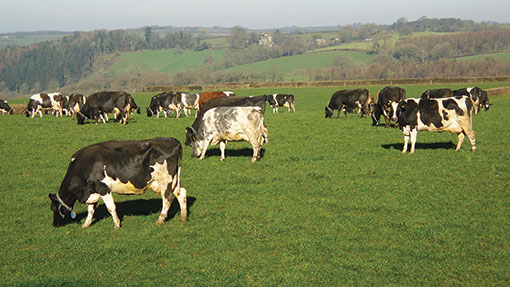Livestock Event 2014: Reducing organic mastitis with holistic treatment

A stress-free environment is key to increasing mastitis resistance on a Devon organic dairy farm, allowing antibiotic use to be reduced. Gemma Claxton reports.
Treating just three cases of mastitis with antibiotics in the last 12 months is no mean feat, but that’s exactly what organic producers Alan and Donna Webber have achieved with their mastitis control plan.
A range of on-farm adjustments have focused on minimising cow stress levels, for example cleaner beds and yards, cows not standing for long spells in the collecting yard and regular parlour servicing. And it is these changes plus the use of alternative therapy that Mr Webber believes have benefited his 200-cow herd’s health, reducing vet costs from 0.9p/litre to 0.67p/litre in the last four years.
“In the last 12 months there have been 24 cases of mastitis. Half were not full blown and a third were stress related, having had previous problems with something else. But we’ve only lost three quarters,” says Mr Webber.
Twice yearly cell counts average 200,000 cells/ml. This rose during the farm’s organic conversion in 2001, but is still within organic limits and has remained steady. Despite this high level, Mr Webber’s herd has a high resistance to mastitis, evident in the few cases shown. Any repeat cases or cows with a history of mastitis are highlighted through herd records and culled.
Holistic therapy
Mr Webber trialled bioenergetic remedies about six to seven years ago to lower antibiotic use and reduce withdrawal times, saving money and milk. The remedies don’t leave residues or have withdrawal periods so as soon as the cow is better, milk can go back to the bulk tank with no delay.
“We’re not spending a large quantity of money compared with when we were buying drugs, and we’ve proven we can cure severe cases of mastitis with bioenergetic remedies. And when something works, we don’t want to change from it,” he adds.
Mr Webber explains how a bioenergetic remedy is produced for the whole herd based on hair and milk samples from cows who’ve had mastitis in the last year. He adds this to the drinking water at a rate of 10ml/300 litres on a regular basis as a preventative measure, alternated daily with remedies for other conditions.
But if any mastitic cows are identified, he adds only the mastitis remedy daily as the first line of defence. The herd test costs £50 and the remedy £100 (for 2.5 litres), which lasts about six months, adds Mr Webber.
Any individual cows picked up in the parlour with mastitis have a milk sample tested for £10 and a personal remedy produced for £12 (for 30ml). This is one million times stronger than the herd health remedy and is the second line of defence, says Mr Webber.
“A few squirts are applied to the vulva each milking to get it into the bloodstream. We’ve been using these remedies for about six to seven years and all cases are recorded so treatments are tailor-made based on herd health history,” he says.
“We massage udder mint on to affected cow’s udders to increase blood flow, which also helps recovery,” he adds.
He regularly checks the temperatures of those undergoing treatment with bioenergetic remedies and says mastitis can take between four to five days for a mild case to clear up and up to two weeks for a serious case.
Including these alternative therapies into his herd health management cost Mr Webber £910 in 2013 for all remedies, £400 of which was on mastitis treatments. He says this has resulted in savings in vet bills, which are now mainly for vaccination and breeding services.
Although seeing monetary benefits from using bioenergetic remedies, Mr Webber admits that while he sees a place for holistic therapy, sometimes it doesn’t work and you have to use antibiotics.
“They sometimes get worse before they get better on the remedies. It’s important to keep monitoring temperatures and treat with antibiotics before the point of compromising health,” he adds.
Lowering stress
Selecting smaller dairy bulls for AI and as sweepers for his autumn block-calving herd means they calve down with no problems. Bulls are also selected with a history of low levels of mastitis and a high resistance to it to strengthen genetic traits in replacements.
Foot-bathing every other day and upgrading the cow yard to slats has reduced slurry and improved hygiene, especially over winter.
“Lots of attention is paid to cubicles. The mattresses are mechanically brushed off every morning before spreading fresh lime. In the evenings we brush them by hand and put fresh sawdust down. In the summer, cows go on to clean paddocks so they’re lying on clean grass after each milking.”
Other measures to keep the udders as clean as possible are hair removal using a torch and tail clipping three times a year.
In parlour, teats are wiped with a paper towel before applying the cluster which has a dual-vac operation. Mr Webber believes the combination of high and low vacuum helps prevent mastitis through improved teat condition. Finally a teat spray is used after cluster removal.
Great care is taken at drying off where surgical spirit soaked cotton wool is used to clean teats before applying an antibiotic-free teat sealant.
Farm Health Planning seminars
For more on managing animal health, visit the Farm Health Planning seminars, including one dedicated to managing mastitis at 12.15pm and 3.15pm on 2 July and 11.50am and 2.50pm on 3 July. The seminars are being held in the Animal Health zone, AH89.
See also: All the news from the Livestock Event
